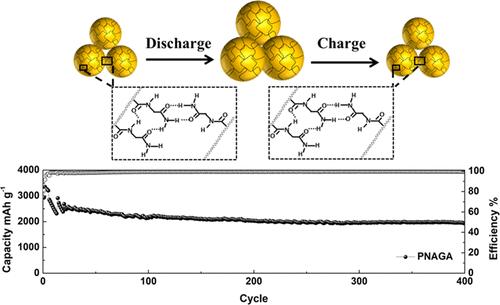当前位置:
X-MOL 学术
›
ACS Appl. Mater. Interfaces
›
论文详情
Our official English website, www.x-mol.net, welcomes your
feedback! (Note: you will need to create a separate account there.)
Multivalent Amide-Hydrogen-Bond Supramolecular Binder Enhances the Cyclic Stability of Silicon-Based Anodes for Lithium-Ion Batteries
ACS Applied Materials & Interfaces ( IF 8.3 ) Pub Date : 2021-05-04 , DOI: 10.1021/acsami.1c04501 Li Deng 1 , Sai-Sai Deng 1 , Si-Yu Pan 1 , Zhan-Yu Wu 2 , Yi-Yang Hu 1 , Kai Li 1 , Yao Zhou 1 , Jun-Tao Li 1 , Ling Huang 3 , Shi-Gang Sun 3
ACS Applied Materials & Interfaces ( IF 8.3 ) Pub Date : 2021-05-04 , DOI: 10.1021/acsami.1c04501 Li Deng 1 , Sai-Sai Deng 1 , Si-Yu Pan 1 , Zhan-Yu Wu 2 , Yi-Yang Hu 1 , Kai Li 1 , Yao Zhou 1 , Jun-Tao Li 1 , Ling Huang 3 , Shi-Gang Sun 3
Affiliation

|
A supramolecular polymer, poly(N-acryloyl glycinamide) (PNAGA), with a bisamide group on each side of the chain forming multiple amide-hydrogen bonds was synthesized in this work as a binder for silicon (Si)-based anodes. This supramolecular polymer binder with improved mechanical properties presents good interfacial adhesion with Si particles forming hydrogen bonds and enhances the adhesive strength between the electrode material film and the copper current collector. Benefiting from the highly stable inter- and intramolecular multiple amide-hydrogen bonds of the PNAGA binder, the electrode structure maintains integrity and a stable solid electrolyte interphase (SEI) layer is formed on the surface of Si particles. The effect of different binders on the composition of the SEI film was also investigated by X-photoelectron spectroscopy (XPS) characterization. In comparison with polyacrylamide (PAM), which has a similar structure to PNAGA, and the traditional sodium alginate (SA) binder, the Si electrode containing the PNAGA binder shows improved electrochemical performance. The capacity retention is 84% after 100 cycles at 420 mA g–1, and the capacity remains at 1942.6 mAh g–1 after 400 cycles at 1260 mA g–1. Even with a mass loading of 1.2 mg cm–2 Si, the electrode with the PNAGA binder exhibits high initial areal capacity (2.64 mAh cm–2) and good cycling performance (81% capacity retention after 50 cycles). Moreover, the application of the PNAGA binder also brings a stable cycle performance to the commercial Si-graphite (SiC) anode material.
中文翻译:

多价酰胺氢键超分子粘合剂增强了锂离子电池硅基阳极的循环稳定性
超分子聚合物poly(N在这项工作中,合成了在链的每一侧具有双酰胺基的双丙烯酰胺基-丙烯酰基甘氨酰胺(PNAGA)(PNAGA)作为基于硅(Si)的阳极的粘合剂。具有改善的机械性能的这种超分子聚合物粘合剂与形成氢键的Si颗粒表现出良好的界面粘合性,并增强了电极材料膜与铜集流体之间的粘合强度。得益于PNAGA粘合剂的高度稳定的分子间和分子内多个酰胺-氢键,电极结构保持了完整性,并且在Si颗粒的表面上形成了稳定的固体电解质中间相(SEI)层。还通过X光电子能谱(XPS)表征研究了不同粘合剂对SEI膜组成的影响。与具有与PNAGA类似的结构的聚丙烯酰胺(PAM)和传统的海藻酸钠(SA)粘合剂相比,包含PNAGA粘合剂的Si电极具有改善的电化学性能。在420 mA g下运行100次后容量保持率为84%-1,容量保持在1942.6毫安克-1在1260毫安克400次循环后-1。即使在质量负载为1.2 mg cm -2 Si的情况下,带有PNAGA粘合剂的电极仍具有较高的初始面容量(2.64 mAh cm -2)和良好的循环性能(50个循环后保持81%的容量)。此外,PNAGA粘合剂的应用还为商业化的Si-石墨(SiC)阳极材料带来了稳定的循环性能。
更新日期:2021-05-19
中文翻译:

多价酰胺氢键超分子粘合剂增强了锂离子电池硅基阳极的循环稳定性
超分子聚合物poly(N在这项工作中,合成了在链的每一侧具有双酰胺基的双丙烯酰胺基-丙烯酰基甘氨酰胺(PNAGA)(PNAGA)作为基于硅(Si)的阳极的粘合剂。具有改善的机械性能的这种超分子聚合物粘合剂与形成氢键的Si颗粒表现出良好的界面粘合性,并增强了电极材料膜与铜集流体之间的粘合强度。得益于PNAGA粘合剂的高度稳定的分子间和分子内多个酰胺-氢键,电极结构保持了完整性,并且在Si颗粒的表面上形成了稳定的固体电解质中间相(SEI)层。还通过X光电子能谱(XPS)表征研究了不同粘合剂对SEI膜组成的影响。与具有与PNAGA类似的结构的聚丙烯酰胺(PAM)和传统的海藻酸钠(SA)粘合剂相比,包含PNAGA粘合剂的Si电极具有改善的电化学性能。在420 mA g下运行100次后容量保持率为84%-1,容量保持在1942.6毫安克-1在1260毫安克400次循环后-1。即使在质量负载为1.2 mg cm -2 Si的情况下,带有PNAGA粘合剂的电极仍具有较高的初始面容量(2.64 mAh cm -2)和良好的循环性能(50个循环后保持81%的容量)。此外,PNAGA粘合剂的应用还为商业化的Si-石墨(SiC)阳极材料带来了稳定的循环性能。





















































 京公网安备 11010802027423号
京公网安备 11010802027423号